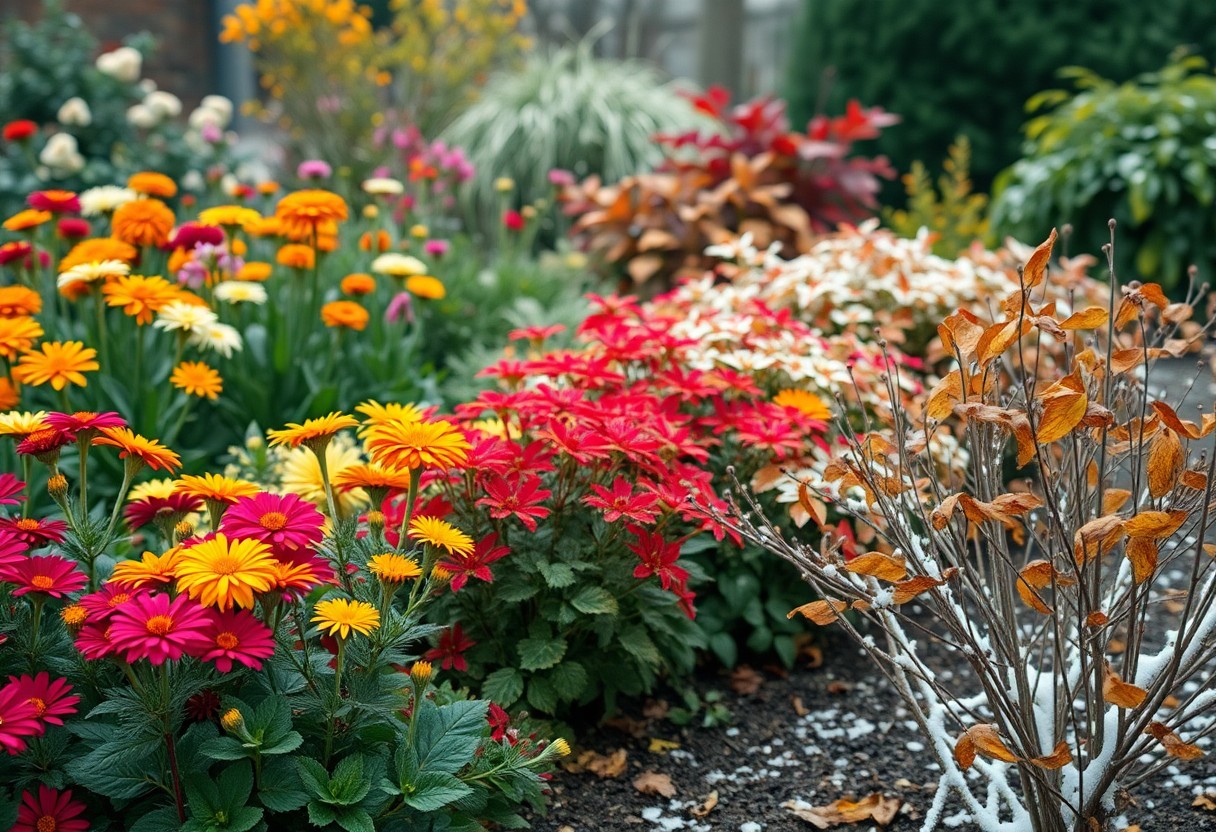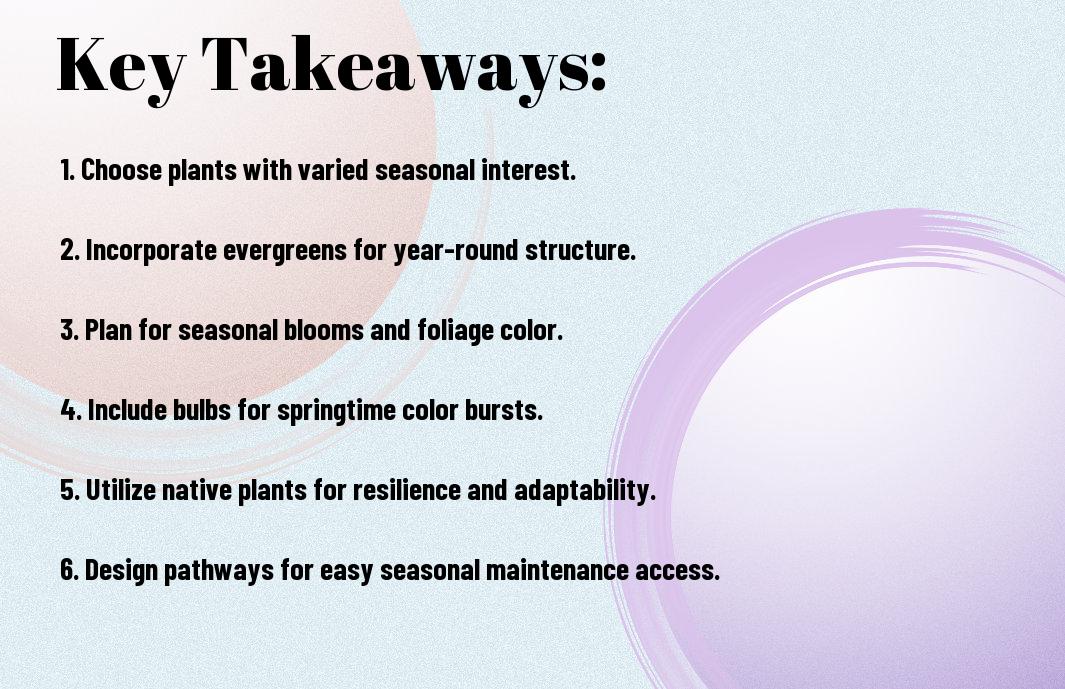You can create a dynamic outdoor space that evolves with the passage of time. As you plan your garden, consider the changing seasons and how your outdoor space can transform with them. Your garden can be a vibrant and engaging reflection of the time of year, with blooms and foliage that shift and change as the seasons come and go, offering you a unique and exciting experience throughout the year.
Key Takeaways:
To create a garden that evolves with the seasons, consider the following points:
- Choose plants with different bloom times to ensure year-round color and interest in your garden, such as spring bulbs, summer flowers, and fall foliage.
- Select shrubs and trees with varying growth habits and texture to add depth and dimension to your garden throughout the seasons, including deciduous and evergreen species.
- Incorporate seasonal elements, such as ornamental grasses, pumpkins, or winter berries, to create a dynamic garden that changes with the seasons and reflects the unique character of each time of year.
Planning for Seasonal Change
The key to creating a garden that changes with the seasons is to plan ahead. You need to consider the different times of year and how your garden will look during each one. This involves thinking about the types of plants you want to include and how they will grow and change throughout the year.
Choosing the Right Plants
Plant selection is vital when it comes to creating a seasonal garden. You should choose plants that thrive during different times of year, ensuring your garden always looks its best. By selecting a variety of plants, you can enjoy a dynamic and interesting garden that changes with the seasons.
Considering Climate and Soil
Above all, you must consider your local climate and soil type when planning your garden. You need to choose plants that are suitable for your area and can thrive in the conditions you have. This will help you create a beautiful and thriving garden that changes with the seasons.
In addition, you should take into account the amount of sunlight and rainfall your garden receives, as well as the temperature and soil pH. By understanding these factors, you can make informed decisions about the plants you choose and create a garden that flourishes throughout the year, with your careful planning and attention to detail, you will be able to enjoy a stunning seasonal garden.
Spring Gardens
Any gardener knows that spring is the perfect time to create a vibrant and dynamic garden. You can find inspiration for your spring garden design by visiting All Season Flower Gardens – Designing Year Round Beauty to get ideas for your own outdoor space.
Planting Bulbs and Seeds
Around this time, you’ll want to start planting bulbs and seeds to ensure a lush garden in the spring. You can choose from a variety of flowers, such as tulips, daffodils, and hyacinths, to add color and texture to your garden.
Creating a Colorful Landscape
For a stunning spring garden, you’ll want to focus on creating a colorful landscape that will bloom throughout the season. You can achieve this by selecting a mix of early-blooming flowers, such as crocuses and pansies, and later-blooming flowers, like peonies and roses.
Planting a mix of annuals and perennials will also help you achieve a dynamic and ever-changing garden. You can plant cool-season annuals like snapdragons and petunias, and perennials like daylilies and coneflowers, to create a vibrant and colorful landscape that will change with the seasons, keeping your garden interesting and beautiful all year round.
Summer Bloom
All your hard work in the spring will pay off as your garden bursts into bloom during the summer months. You’ll enjoy vibrant colors and lush textures, and your outdoor space will be perfect for relaxation and entertainment.
Managing Growth and Pruning
Following a regular pruning schedule, you’ll be able to keep your plants healthy and thriving, and prevent overgrowth from taking over your garden. You’ll need to deadhead flowers and trim back foliage to maintain shape and promote new growth.
Incorporating Summer Flowers
Mastering the art of combining summer flowers, you’ll create a stunning display of color and texture in your garden. You can choose from a wide range of blooms, such as sunflowers, zinnias, and cosmos, to add vibrancy to your outdoor space.
In addition, as you select summer flowers, consider their growth habits, bloom times, and soil requirements to ensure that they thrive in your garden. You can also incorporate summer-blooming shrubs and trees to add depth and structure to your landscape, and provide a beautiful backdrop for your summer flowers.
Autumn Harvest
Many gardeners look forward to the autumn season, as it brings a new wave of colorful blooms and fruitful harvests. You can create a beautiful and thriving garden during this time by preparing your soil, planting seasonal flowers, and maintaining your garden’s health.
Preparing for the Fall Season
About this time, you should start cleaning up your garden, removing dead plants and debris, and adding a layer of compost to your soil. You will be preparing your garden for the upcoming season, and setting it up for success.
Planting Autumnal Blooms
Around autumn, you can start planting flowers that thrive in cooler temperatures, such as pansies, asters, and chrysanthemums. You can choose from a variety of colors and textures to add depth and interest to your garden.
Autumnal blooms can add a pop of color to your garden, and you can enjoy them well into the fall season. You can plant them in containers or directly in the ground, and with proper care, they will bloom for weeks, providing you with a beautiful display of color and a sense of accomplishment in your gardening endeavors.
Winter Wonderland
Despite the cold temperatures, your garden can still be a beautiful and inviting space during the winter months. With a little planning, you can create a winter wonderland that showcases the season’s unique charm.
Creating Interest in Snowy Landscapes
Conceptualizing a snowy landscape can be a fun and creative process. You can add interest to your winter garden by incorporating elements like snow-covered sculptures, frosted berries, and bare tree branches that create a beautiful silhouette against the sky.
Planting Evergreens and Winter Flowers
Before you start planting, consider the types of evergreens and winter flowers that thrive in your climate. You can choose from a variety of plants like holly, boxwood, and winter heather to add some color and texture to your garden.
Understanding how to care for your evergreen and winter flower plantings is key to keeping them healthy and thriving. You’ll want to make sure to water them regularly, but avoid overwatering, which can be detrimental to their health. By choosing the right plants and providing proper care, you can enjoy a beautiful and vibrant garden even in the dead of winter, and your garden will be a beautiful reflection of your personal style and creativity.

Maintenance and Care
For a garden that changes with the seasons, you’ll need to stay on top of maintenance and care tasks to ensure your outdoor space remains beautiful and thriving.
Seasonal Cleanup and Preparation
Around the changing of the seasons, take time to clean up your garden, removing dead plants and debris, and prepare for the upcoming season by planting new flowers, shrubs, or trees that will bloom during that time.
Tips for Year-Round Garden Health
Genuinely, you can keep your garden healthy year-round by following a few simple tips:
- watering plants regularly
- mulching to retain moisture
- pruning to promote growth
, Recognizing the unique needs of your garden will help you create a space that flourishes in every season.
YearRound garden health is your goal, and you can achieve it by staying on top of tasks such as:
- monitoring temperature and weather changes
- adjusting your watering schedule accordingly
- adding fertilizers or soil conditioners as needed
, Recognizing the importance of adaptability and flexibility in your gardening routine will help you create a thriving and dynamic outdoor space.

Conclusion
Ultimately, you now have the tools to create a garden that changes with the seasons. You can design and plant your garden to showcase vibrant colors and textures throughout the year. By choosing the right plants and incorporating seasonal elements, you will enjoy your outdoor space in every season, and your garden will be a dynamic reflection of your personal style and connection to nature.
FAQ
Q: What are the key elements to consider when creating a garden that changes with the seasons?
A: To create a garden that changes with the seasons, consider the climate, soil type, and the amount of sunlight your garden receives. Choose a mix of plants that bloom or change color during different times of the year, such as spring bulbs, summer flowers, autumn foliage, and winter berries. Incorporate decorative elements like seasonal decor, lighting, and furniture to enhance the garden’s ambiance throughout the year.
Q: How can I select plants that will provide year-round interest in my garden?
A: Selecting a variety of plants with different growth habits, textures, and bloom times is crucial for a garden that changes with the seasons. Consider plants with interesting foliage, such as ornamental grasses, or those with attractive bark, like deciduous trees. Incorporate plants that produce showy flowers, berries, or seeds, and include a mix of evergreen and deciduous plants to provide year-round structure and interest.
Q: What role does maintenance play in keeping my seasonal garden looking its best?
A: Regular maintenance is necessary to keep your garden looking its best throughout the year. This includes tasks like pruning, deadheading, and dividing plants as needed. Add a layer of mulch or compost to retain moisture, suppress weeds, and regulate soil temperature. Stay on top of seasonal tasks like planting spring bulbs, trimming summer growth, and protecting plants from harsh winter weather to ensure your garden continues to thrive.
Q: How can I incorporate seasonal decor and furniture into my garden design?
A: Incorporating seasonal decor and furniture can add an extra layer of interest to your garden. Consider adding seasonal-themed planters, garden ornaments, and outdoor lighting to create ambiance and highlight your plants. Use outdoor furniture like benches, tables, and chairs to create inviting spaces for relaxation and entertainment during different times of the year. Switch out decorative elements seasonally to keep your garden looking fresh and updated.
Q: Are there any specific design principles I should follow when creating a garden that changes with the seasons?
A: When designing a garden that changes with the seasons, consider the principles of layering, texture, and movement. Create layers of plants with different heights, textures, and growth habits to add depth and interest. Incorporate a variety of textures, from smooth to rough, to create visual appeal. Use plants with movement, like grasses or perennials with flowing foliage, to add dynamic energy to your garden. Balance these elements with resting spaces, like a quiet seating area, to create a harmonious and engaging outdoor space.
